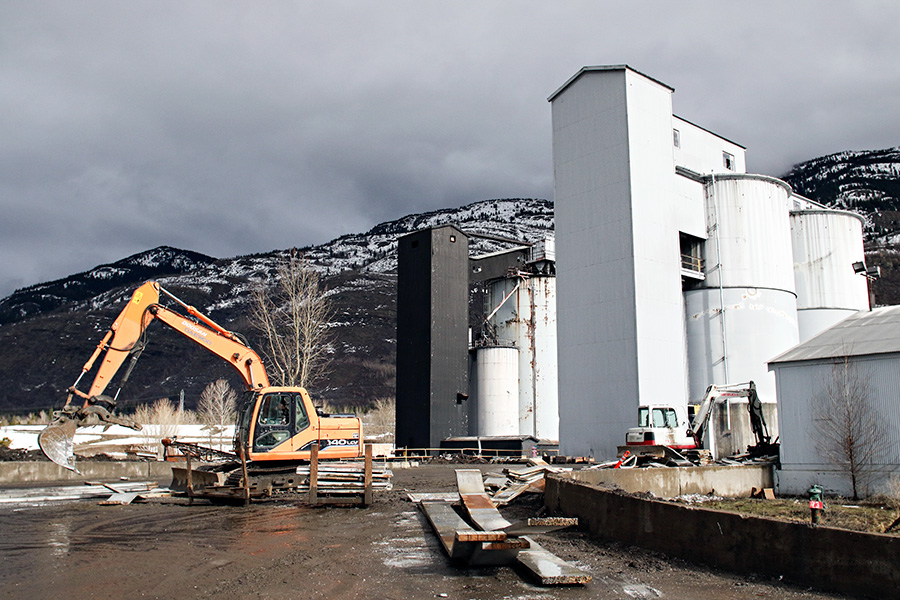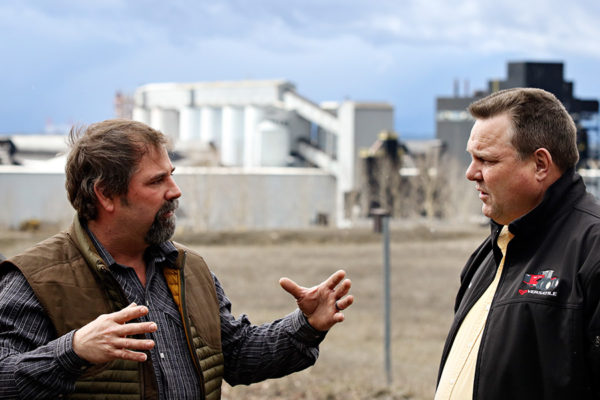Montana and the EPA: A Complicated Relationship
The federal agency in charge of protecting public health and the environment has an important yet contentious role in the Treasure State. What happens if that role is reduced?
By Dillon Tabish
From Libby to Columbia Falls, Kalispell to Butte, the U.S. Environmental Protection Agency plays a prominent role in Montana. The Treasure State, with its extraction-industry allure, is home to some of the largest and worst contaminated sites in U.S. history, making “Superfund” a household term and thrusting the nation’s foremost hazardous waste cleanup program onto communities across the state since its inception in 1980. That has produced a unique and complicated relationship between the state and the EPA, which is in charge of protecting public health and the environment.
Montanans have a love-hate relationship with the agency, many appreciative of its work and vital role as an environmental and public-health watchdog, yet others frustrated with its lingering presence, regulations and vexing protocol.
The embattled federal agency is under fire in Washington, D.C., where the Trump administration is proposing to slash its funding by nearly one-third. The White House recently announced its budget proposals, including $5.7 billion for the EPA, a 31 percent cut from the previous budget year. The reduced budget would be the smallest, adjusted for inflation, since the initial years after President Nixon established the agency in 1970. The cuts would eliminate an estimated 3,800 jobs and impact programs such as Superfund.
President Trump and EPA Administrator Scott Pruitt have defended the cuts by demonizing the agency as a job-killing federal bureaucracy that imposes unnecessary regulations on U.S. communities, such as carbon-emissions standards to combat climate change and clean air and water directives.
The Trump administration is seeking to give states more control over environmental laws but is proposing to reduce grants to help fund those efforts by more than half.
Democrats, such as Montana Sen. Jon Tester, have slammed Trump’s overall budget proposal. Tester said it’s “irresponsible and will hurt rural America and Montana’s economy, while giving tax cuts to the wealthy and wasting billions on an ineffective wall.”
Whether the EPA cuts will survive through Congress remains to be seen.

Congress and President Nixon created the EPA at a time when environmental disasters were becoming commonplace across the country. One of the most infamous crises involved the Love Canal disaster in New York, where a toxic landfill leaked contaminants into the surrounding neighborhoods and sickened hundreds of residents.
Bipartisan support in D.C. led to the creation of the EPA and the first National Priorities List, which distinguishes the most contaminated sites and uses the Superfund program to spur cleanup. The initial list was published in 1983, with 406 sites identified for critical and complex cleanup. Today more than half of those original sites remain intertwined in the program.
There are currently 1,337 sites overall in the Superfund program, including 17 in Montana, which is one of the highest totals per capita. About one in six Americans, or roughly 53 million people, live within three miles of a Superfund site, according to a 2015 report cited in USA Today.
Most recently, the Columbia Falls Aluminum Company plant was placed on the NPL, and the 960-acre property on the outskirts of town, along the Flathead River, is in the early stages of investigating the potential scope of contamination. The first round of site samples identified cyanide and other harmful elements at the property.
When the EPA was deciding whether to declare CFAC a Superfund site, community members debated whether they wanted it, with many people worried about “the Superfund stigma” and the lengthy process that could extend well beyond a decade.
Through the Superfund program, the EPA can pay for the initial investigation and remediation costs but eventually finds a responsible private party to fund the cleanup program.
Lincoln County was designated a Superfund site in the early 2000s. For years, the W.R. Grace & Co. mined asbestos-laced vermiculite north of Libby that was used for insulation and other applications. The mine closed in 1990. More than 2,000 current or former residents of Lincoln County have been diagnosed with asbestos-related diseases, including cancer, and at least 400 have died in the last decade.
It was one of the largest Superfund sites in America and in 2009 became the nation’s first and only Public Health Emergency resulting from an environmental disaster. It’s only now coming to a conclusion.
Last week new tests found elevated levels of arsenic and lead in a children’s sandbox at a city park in Anaconda, the result of an old smelter. Of the 55 test pits in the park, only four were clean, according to the EPA, which continues to oversee cleanup and remediation in the area. The agency plans to remediate roughly 1,000 properties in Anaconda for excessive toxic metals in the soil.
One of the most infamous and confounding examples of environmental crises is down the highway from Anaconda. The Berkeley Pit in Butte continues to slowly fill with toxic water. The former open pit copper mine remains a Superfund site without a solution in sight. The EPA and others are trying to figure out how to address the 900-foot-deep body of water that stretches one mile long and half a mile wide.
Experts estimate the pit water level will reach the natural water table by 2023, which will lead to heavy metals and dangerous chemicals discharging into the surrounding groundwater. In that event, the best solution that has been proposed is pumping and treating the water, in perpetuity.

Ask many local business and civic leaders about the EPA and it elicits a similar response: a sigh blended with exasperation and appreciation.
In the city of Kalispell, the federal agency is considered by many to be both a boon and a boondoggle. On one hand, it helps the municipality clean up former industrial properties that are blighted and hampered by historical contamination and other hazardous conditions, factors that deter private property reinvestment. In just the last five years, Kalispell has received $1.4 million in Brownfields grant funding through the EPA. These funds, which city officials would be hard-pressed to find in their annual budget, are currently being used to help clean up and revitalize the core area of Kalispell and spur economic redevelopment.
On the other hand, the EPA delivers strict mandates that cities must follow involving sewer and stormwater discharge, among other regulated city resources, as part of the agency’s mission to protect human health and the environment.
Sometimes these mandates involve hefty standards that require constant — and expensive — upkeep, creating unfunded burdens that can beset cities, especially in rural regions such as the Flathead Valley.
“Some of the regulations they come up with are extremely burdensome because the technology does not exist or is not in place to achieve the goals they set with those regulations,” Kalispell City Councilor Phil Guiffrida said.
“In Kalispell they set a specific phosphorous or water temperature, and they set a specific goal to achieve, but the technology either doesn’t exist to achieve that goal or we don’t have it. They get the cities to fund the technology to achieve those goals. It’s a huge fiscal burden to upgrade to that situation.”
In 2009, Kalispell invested $22 million into expanding and improving its wastewater treatment facility on Airport Road. At the south end of Flathead Lake, Polson is preparing to break ground on a new $12.2 million wastewater treatment plant.
“Clean air and clean water is good, but the cost factor to get to achieve those goals can be completely outrageous,” Guiffrida said.
“(The EPA) is a double-edged sword. There’s a lot of good things with the bad. The Brownfields program is something that’s extremely successful. Look at the cleanup we’re doing because of those grants. The same with Superfund sites. Without the cleanup, there would be no redevelopment.”

Ask Vicki Watson about the EPA and its potentially reduced presence on the landscape, and it prompts a question: what if?
What if there wasn’t a Superfund cleanup program? What would happen to contaminated sites if the EPA shrunk in size? Who would hold companies accountable for leaving behind hazardous byproducts that harm the environment and public health?
Watson, a longtime environmental studies professor at the University of Montana in Missoula, can see the direct impact of the EPA’s influence every time she walks along the Clark Fork River. In the 1980s, mining waste from the Butte area had contaminated the expansive river system, and arsenic was discovered in the groundwater near Milltown, outside Missoula. The dangerous contamination, which directly threatened at least 35 households, quickly made the Milltown Reservoir one of the first Superfund sites in the nation in 1983.
Today, the Milltown Dam is gone and the river system has been largely remediated and restored, improving the ecological conditions and eliminating the sizable public health hazard. Atlantic Richfield Company, or ARCO, was the private company held responsible by the EPA and has paid nearly $500 million to date as a result of the entire Superfund cleanup program that traces up the Clark Fork to Butte.
“Silver Bow Creek (near Butte) had almost nothing alive in it for almost 100 years,” Watson said. “And now it has westslope cutthroat trout.”
“Not only did that (cleanup) help the people of Montana, we turned around that creek and hopefully we will be able to continue to improve the Clark Fork drastically. And that (Superfund cleanup) provided a lot of good jobs over the years. A lot of money was spent in Montana.”
So, considering the improvements in the Clark Fork, as well as Libby and other remediated areas, why is the EPA frowned upon by many?
“When the Superfund law passed, there was a recognition that we had a lot of old, abandoned, contaminated sites that no one was taking responsibility for … I think it turned out to cost more than people thought it would to really clean up these sites and fix them in a permanent way,” Watson said.
“They thought it would only involve digging up a few barrels and sticking them in a hazardous landfill. Dealing with landscape-level contamination like we have in the Clark Fork, that takes a lot of time and money to figure out how to deal with that scale and scope.”
Correction: The article previously stated the Lincoln County Superfund site was the largest in America. It was one of the largest, but the Milltown Reservoir/Clark Fork River Superfund site was, in fact, the largest.